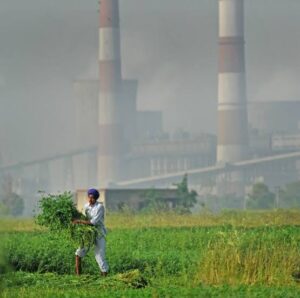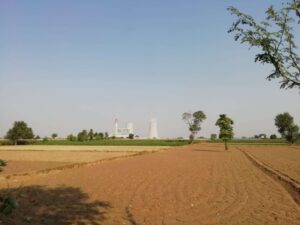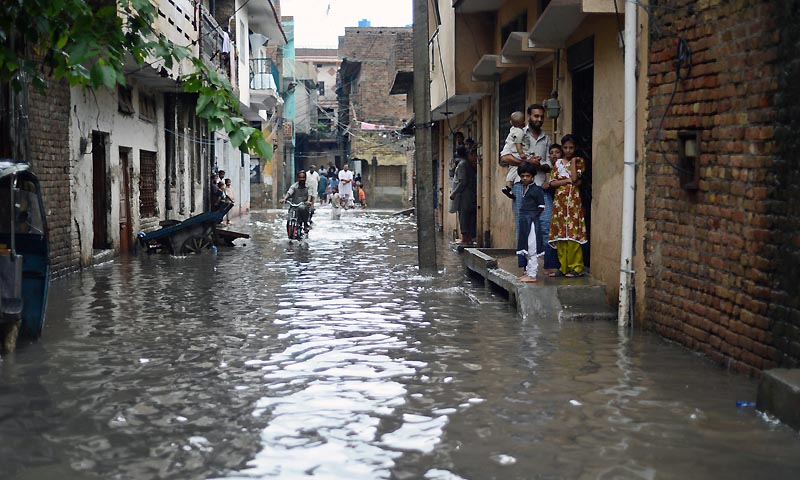Coal-fired power plants are causing havoc in Pakistan

Saddia Mazhar
Sahiwal: The Sahiwal Coal Power plant project named Huaneng Shandong Ruyi (Pakistan) Energy (Limited) in Qadirabad is a mega coal power project which is a part of the China-Pakistan Economic Corridor (CPEC). The power plant is located about (12 miles) from Sahiwal and (9.3 miles) from Okara cantonment, just north of the road which connects the two towns, in Pakistan’s Punjab Province.
It was initiated to overcome the electricity shortage in Pakistan. China invested US$ 1.912 billion on this particular project in collaboration with the Pakistani Government. Currently, Pakistan has four working coal plants while four are under construction in different parts of the country, all under CPEC.
Coal is a significant part of the generation mix. The year 2019-2020 saw 19% of the power generation in the country coming from just four coal-fired CPEC power plants. The 4.62 GW of CPEC-funded coal-fired generation includes the 1,320 MW Huaneng Shandong Ruyi-Sahiwal Coal Power Plant; the 1,320 MW Port Qassim Coal-Fired Power Plant; the 1,320 MW HubCo Coal-fired power plant and the 660 MW Engro Thar Coal Power Plant which started supplying electricity to the national grid between 2017 and 2019.
In 2014, the population of Qadirabad was 102,555 and now the population has decreased to 32,555. Why?
During the trailblazing of the Sahiwal Coal Power Project in 2014, the then Prime Minister Nawaz Sharif had told locals they will be rewarded according to their demands if they cooperated with them in this project. But now, the people and the farmers of the region tell a different story. The total land occupied by the project is 1012 acres and 7 marlas. At what price the Government purchased this land is still not clear. The company claims that it bought the land from the government and has no idea how much the government paid to the people.
“We own the land of our forefathers as farming is our occupation but in 2014 when the government showed their intention to purchase the land, we did not have any other option but to sell. We had a total of 1 acre of land between me, my brothers, and sons,” said Ishaq, a farmer.

“We left Qadirabad after that and purchased houses in the city. My sons are now in Karachi engaged in different businesses but I miss my land. The government never helped us to purchase any land in alternative places or to start any business. It did not even provide clean water, schools, and a small health dispensary. They just made false claims,” he added.
The mega project is affecting life in the area by burning 16,667 tonnes of coal daily and throwing ash and smoke into the air. The report of an Environmental Impact Assessment (EIA) conducted by the National Engineering Services Pakistan (NESPAK) to assess the impact of the 1,360MW coal power plant project on fertile agricultural land has suggested many steps including a proper system of fuel wastage, 30,000 tree plantation project with the height of 6 to 7 feet; compensation for the farmers in the form of agricultural land and compensation for the loss of crops too. But the most important suggestion was to employ an environment expert in the company.
“We believe green is the way to go,” Asad Umar
People who sold their land left Qadirabad, they did not get any compensation in form of land, and some did buy land but on their own. Talking about the environmental effects, just wash a white cloth/shirt and put it on roop to dry in the air, you will find a comparatively dark shirt after some hours, the air is that much polluted. Villagers say the power plant has impacted not only their health but change their whole view of life once they were living. Their houses were surrounded by green fields as far as the eye could see. They remember what it felt like to breathe fresh air. And they remember the sense of ownership they felt towards their land.
Tim Flannery in” Atmosphere of hope” (2015) said, “In northern China, air pollution from the burning of fossil fuels, principal coal, is causing people to die on an average of 5.5 years sooner than they otherwise might.”
They used imported coal from South Africa because the burning quality of Pakistani coal is not good this coal was first landed by ships at Karachi port and a special rail lane was used to transport this coal to the Sahiwal coal power plant. “We are using the latest technology in the coal power plant which is called Super Critical technology, “ Chinese workers said. But experts claim that the coal used in the plant is of the worst quality, known as ‘lignite-based coal’ with a calorific value of less than 3000 kcal. It takes 1 kg of coal to make 1 unit of electricity while normal coal, uses just 0.4 kg per unit of electricity.

The levels of various environmental contaminants in the ambient atmosphere such as toxic gases, including Sulphur dioxide, carbon monoxide, nitrous oxide, and (ultra) fine particulate matter, are significantly increased compared to their previous (acceptable) levels in the air, an environmentalist from the University of Agriculture Faisalabad added.
At the Climate Ambitions Summit held in December 2020 to commemorate the fifth anniversary of the Paris Agreement, Prime Minister Imran Khan made three commitments: Pakistan will
a) generate 60pc of her energy from renewable resources,
b) ensure that 30pc of the vehicles in the country will be electric vehicles (EV)
c) not pursue coal plants and there will be no coal power plants in Pakistan.
In August 2020, the Pakistan government formally approved the Alternative and Renewable Energy Policy 2019. The new policy aims to boost the share of electricity generated from renewable sources from around 5 percent at present to 20 percent by 2025 and 30 percent by 2030.
Just a few weeks ahead of COP26, China, the world’s biggest public financier of coal, announced that it will end investments in overseas coal projects. It raised hopes in countries that want to make low-carbon energy plans and panic among those who feel they cannot do without coal.
“We believe green is the way to go,” Asad Umar, Pakistan’s federal minister for planning, development, and special initiatives said. “We have always been very critical of the coal plants that we inherited from the previous government,”
“The worst environmental condition in the country may force the government of Pakistan to focus on the much-ignored area of solar power.”
“Pakistan is the hottest place on the earth which means it is largely facing the adverse effects of climate change without having any kind of role in the emission of greenhouse gases. Pakistan is a country that has really shifted its direction and has shown to the world what can be done if you have the right vision about climate change, Pakistan has shut down two coal-powered power plants having a capacity of 2,400 megawatts and initiated hydel power plants that will generate 3,700 megawatts of electricity,” he added
“The world must come up with nature-based solutions and it should also provide funds to those developing countries like Pakistan that are being affected by negative impacts of the climate change. the Minister said.
Why do Coal power plants take over agricultural land?
“It’s an environmental disaster as coal has negative consequences on air quality, is a water-intensive technology and it could affect the fertility of agriculture plains, and most importantly, exacerbate climate change,” experts say.
They insist that the project makes little business sense. “How could you allow a coal power plant to be constructed in an agriculture zone, where there are no coal reserves?” they question. “Such projects need to be investigated as these so-called assets will become liabilities due to high operational, maintenance, and environmental costs and must not be allowed in the future,” they add.
Science is clear on the fact that coal is exacerbating climate change which leads to catastrophic weather events such as a glacial lake, outburst floods, cyclones, and sea intrusion.
“Patients’ numbers have increased in last seven years, with chest infections, asthma, dry cough and lungs problems. Surely the reason is the coal plant because the smoke comes out from the plant. Lahore is ranked the top city in the world for smog, Abrar Ahmad, said.
“Once I was traveling from Lahore to Sahiwal in public transport, a villager was on call and was having the worst cough. During the call, he said that after the establishment of this coal plant, we residents of Qadirabad are facing the worst chest infections. Our Children are suffering badly,” Ahmad added
While China is moving away from coal-fired plants, it readily agrees to transfer this technology to Pakistan. China is now using natural resources to produce several useful products that include; SNG, urea, anhydrous ammonia, crude acrylic acid, phenol, diesel, naphtha, tar oil, and so on. But the burning coal in the 21st century is a sin.
In the present ‘Smog Crisis ‘, coal-fired power plants have been shut down around New Delhi while the Sahiwal plant continues to pollute the air of Lahore. Immediate action is needed. Government should shut down the plant. This plant and the Orange Train of Lahore are both funded through CPEC (China Pakistan Economic Corridor). Now the Punjab government has shut down schools for extended weekends (Saturday, Sunday, and Monday).
Muhammad Badar-ul-Munir, the chief executive of the 100 MW Quaid-e-Azam Solar Power Pvt Ltd (QASPL) plant, said: “The worst environmental condition in the country may force the government of Pakistan to focus on the much-ignored area of solar power.”
Environmental experts have to be involved to look at all possible options together with implementation which has always been the missing link in Pakistan. But in the meantime let’s shut down the Sahiwal Coal Power plant for immediate relief to the suffering people of Lahore and Sahiwal. Currently, there is an excess power generation and a shortage of clean air to breathe. Let’s give a break to our respiratory system before it collapses resulting in another pandemic for which we are not prepared. Government should focus on green energy initiatives and zero-carbon projects. People do not have health facilities in these small towns. Clean water is another big issue due to which people are suffering from hepatitis, malaria, and typhoid. These coal power plants pollute water.
The shift to renewables will have multiple benefits for Pakistan, including reduced cost of electricity and improved energy access, and energy independence. It will also create opportunities to establish new industries in the renewable energy supply chain and develop human capital through job creation, with the added benefit of greater resilience against the impacts of climate change and a healthier workforce through reduced pollution.


